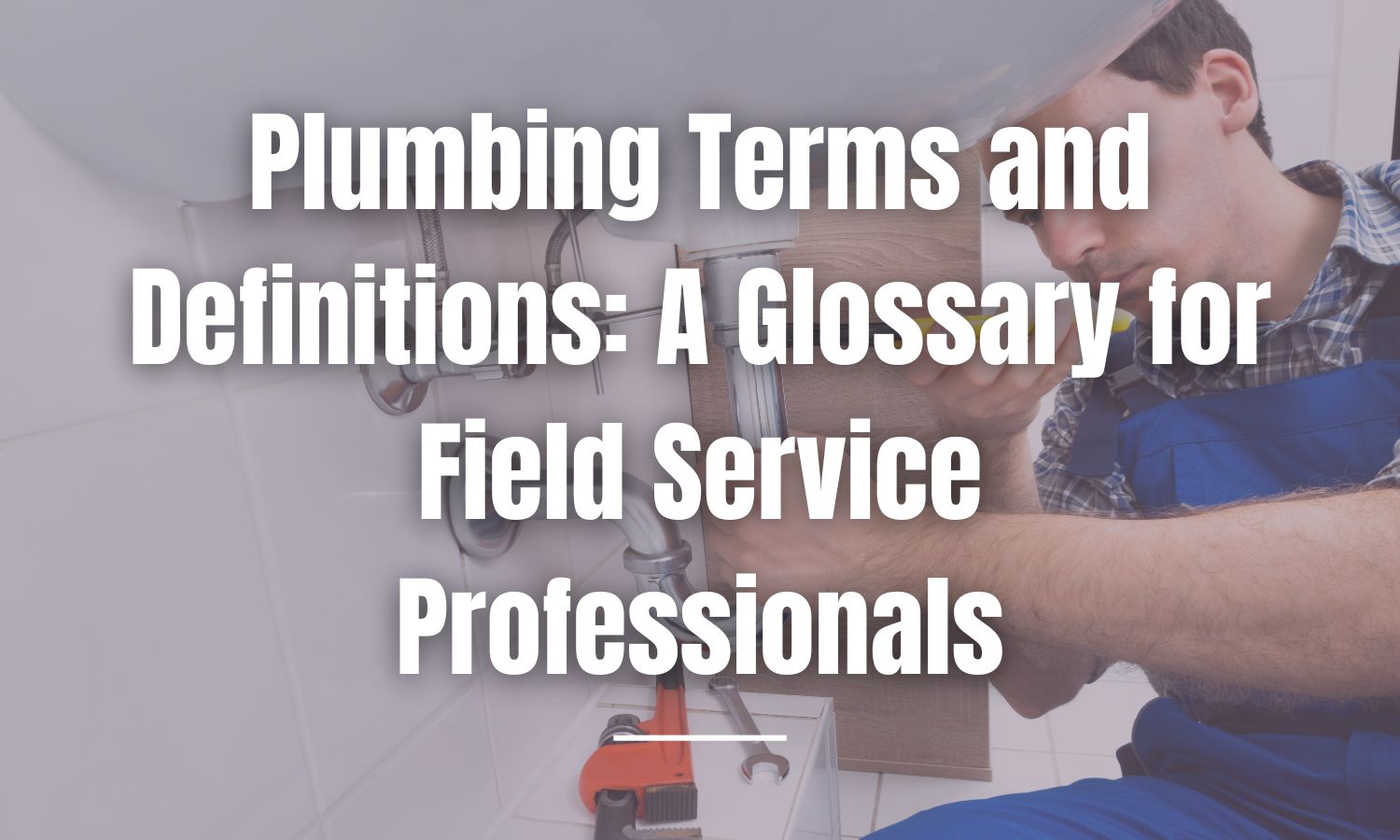Whether you’re a field service professional, a contractor or a business owner, mastering key plumbing terms and definitions helps streamline operations and improve customer interactions.
From training new technicians to conversing with customers and suppliers, it’s crucial to know how to relay key plumbing terms and definitions to customers to ensure effective communication and efficient work.
Even if you’re not in the plumbing industry itself, having a basic understanding of these plumbing terms is important for anyone in the field services industry.
Below, we’ve compiled a glossary of essential plumbing terms and definitions for field service pros like yourself.
Why Plumbing Terms and Definitions Matter
No matter what field service industry you’re in, it’s important to understand key plumbing terms and definitions for several reasons:
- Improved communication: ensures clear discussions between plumbers, contractors, suppliers and customers
- Efficient troubleshooting: speeds up diagnostics and problem resolution
- Enhanced training: helps new plumbers or technicians learn the trade faster
- Better customer service: educating customers on basic plumbing terms improves transparency and trust
Basic Plumbing Terms
1. Potable Water
Potable water is safe for drinking and general household use. It has been treated and tested to meet local and national health standards.
- Fact: The U.S. has one of the safest drinking water supplies in the world, with 90% of people getting their water from regulated sources.
2. Greywater
Greywater is wastewater that comes from sinks, showers and washing machines. Unlike sewage, greywater can sometimes be reused for irrigation and flushing toilets.
3. Blackwater
Blackwater refers to wastewater containing human waste, typically from toilets. It requires special treatment before being safely disposed of or reused.
4. Hard Water vs. Soft Water
- Hard Water: Water with a high mineral content, usually containing calcium and magnesium. It can cause scale buildup in pipes and appliances.
- Soft Water: Water that has been treated to remove excess minerals, making it better for plumbing systems and appliances.
- Fact: Around 85% of homes in the U.S. have hard water, which can shorten the lifespan of water heaters and pipes.
Plumbing Components and Fixtures
5. P-Trap
A P-trap is the curved pipe beneath sinks and other fixtures. It holds a small amount of water to prevent sewer gases from entering the home.
6. Shut-Off Valve
A shut-off valve controls the water supply to specific fixtures or the entire building. There are two main types:
- Angle stop valve: Common under sinks and toilets
- Ball valve: Provides a more durable and reliable shut-off
7. Water Meter
A water meter measures the amount of water used in a home or business. It helps customers monitor water usage and detect leaks.
8. Flapper Valve
A flapper valve is a rubber seal inside a toilet tank. It lifts when the toilet is flushed, allowing water to flow into the bowl.
9. Sump Pump
A sump pump removes excess water from basements or crawl spaces to prevent flooding. It is especially important in areas with heavy rainfall or high water tables.
- Fact: The U.S. experiences billions of dollars in flood damage annually, making sump pumps a crucial part of many homes.
Common Plumbing Pipe Terms
10. Pipe Fittings
Pipe fittings connect different sections of pipe or change the direction of flow. Common types include:
- Elbow: Changes pipe direction (e.g., 90-degree or 45-degree bends)
- Tee: Creates a T-shaped junction to split flow
- Coupling: Connects two pipes in a straight line
11. PVC (Polyvinyl Chloride) Pipes
PVC pipes are commonly used for residential plumbing because they are lightweight, durable and resistant to corrosion.
12. Copper Pipes
Copper pipes are known for their longevity and resistance to rust. They are often used for water supply lines.
- Fact: Copper pipes can last from 50-70 years, making them one of the most durable plumbing materials.
13. Galvanized Pipes
Galvanized pipes are steel pipes coated with zinc to prevent rust. However, they can corrode over time and are less common in modern plumbing.
14. ABS (Acrylonitrile Butadiene Styrene) Pipes
ABS pipes are black plastic pipes used for drainage and venting. They are similar to PVC but stronger and more impact-resistant.
Plumbing Repair and Troubleshooting Terms
15. Water Hammer
Water hammer is a loud banging noise in pipes caused by sudden changes in water pressure. It can damage pipes over time.
16. Backflow
Backflow occurs when contaminated water flows backward into a clean water supply, often due to pressure changes.
17. Water Pressure Regulator
A water pressure regulator controls the pressure of incoming water to prevent damage to plumbing systems.
- Fact: The ideal household water pressure is between 50-70 psi. Excessive pressure can lead to leaks and pipe bursts.
18. Leak Detection
Leak detection involves using specialized tools to find hidden leaks in pipes, walls or underground. Common methods include:
- Acoustic sensors: Detect water movement inside walls
- Infrared cameras: Identify temperature changes caused by leaks
- Pressure testing: Measures changes in pipe pressure to locate leaks
Advanced Plumbing Industry Terms
19. Hydronic Heating
Hydronic heating uses water to transfer heat through a system of pipes, radiators or underfloor heating. It is energy-efficient and provides even heating.
20. Cross-Connection
A cross-connection is a direct link between potable water and a potential contamination source. Proper backflow prevention is needed to prevent contamination.
21. Greywater Recycling
Greywater recycling involves treating and reusing water from sinks, showers and laundry for irrigation or toilet flushing.
22. Sewer Cleanout
A sewer cleanout is an access point that allows plumbers to clear clogs from a main sewer line.
- Fact: In the U.S., over 500,000 sewer backups occur each year, often due to clogged pipes.
Want to save money and time? Schedule a personalized FieldEdge demo today!
Mastering Plumbing Terms for Success
Understanding plumbing terms is essential for field service pros like yourself. Whether diagnosing issues, explaining repairs to customers or ordering materials, knowing the right terms can improve efficiency and reduce misunderstandings (even if you’re not in the plumbing industry).
Here are some key takeaways from this plumbing glossary:
- Knowing plumbing terms improves communication with customers and suppliers.
- Proper terminology helps diagnose and fix issues faster.
- Learning about plumbing materials and components ensures the right choices for projects.
- Industry knowledge makes your business more professional and trustworthy.
- Investing in ongoing education keeps your service business competitive.
By mastering these plumbing terms, your team can work smarter, serve customers better and stay ahead in the field service industry.
Mastering plumbing terminology is a great step toward improving communication and efficiency in the field. To take your operations even further, Plumbing Software can help streamline scheduling, invoicing, and customer management, so your team can focus on delivering top-notch service.
Related: 10 Essential Plumbing Tools Your Business Needs




